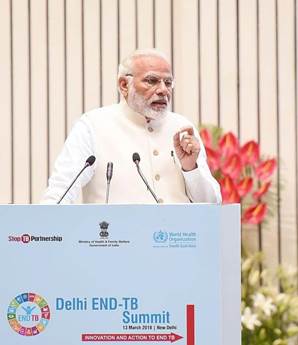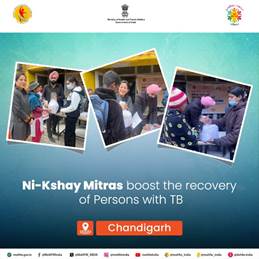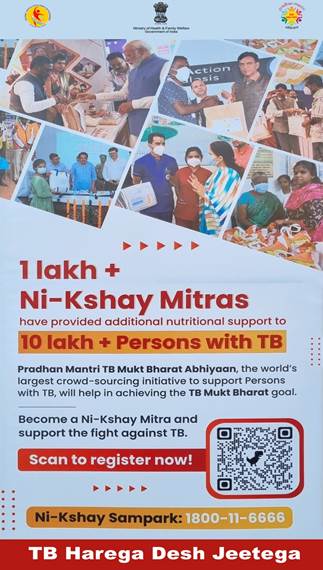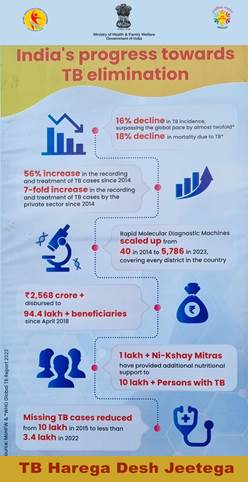One of the biggest killers, Tuberculosis (TB) is an infectious disease and found in every part of the world. It continues to be a major public health issue of global concern. India carries one of the largest global burden of the disease. The central and state governments are committed to ending it by 2025, five years ahead of the global target under the Sustainable Development Goals (SDG) 2030. Let us deep dive into the different aspects of the disease and understand India’s initiatives in this direction.
Global burden of TB
TB is an infectious airborne disease caused by Mycobacterium tuberculosis (M.tb). WHO estimates that nearly 1.8 billion people, accounting for close to 1/4 of the global population, are infected with TB. Approx. 13 lakh children get sick with TB each year. It is one of the leading infectious causes resulting in worldwide deaths. Last year, TB was noted to be the world’s second leading cause of death from a single infectious agent, after COVID-19. It caused almost twice as many deaths as HIV/AIDS. In 2022, 1.06 cr were infected from TB and 14 lakh died due to it. TB results in 3500 deaths on a daily basis.
Tuberculosis is strongly influenced by different social and economic and health-related risk factors. These are undernutrition, diabetes, HIV infection, alcohol use disorders and smoking. According to WHO, on the global scale in 2020, an estimated 19 lakh incident cases of TB were due to undernutrition, 7.4 lakh to HIV infection, 7.4 lakh to alcohol use disorders, 7.3 lakh to smoking and 3.7 lakhn to diabetes. Although, there are regional and national variations. For instance, a high incidence is noticed among the urban population living in slums.
Thirty countries that bear a high TB burden account for 87% of the world’s total TB cases. Of these, two-thirds of the global total burden was found in eight countries.
India accounts for a large share at 27% of the total global cases followed by Indonesia (10%), China (7.1%), the Philippines (7.0%), Pakistan (5.7%), Nigeria (4.5%), Bangladesh (3.6%) and the Democratic Republic of the Congo (3.0%).
WHO commends India’s strides
The World Health Organisation (WHO) Global TB Report 2023 has credited India for its noteworthy activities and interventions towards a tuberculosis free country. WHO has appreciated India for its highly significant progress in reducing the incidence of tuberculosis by 16 per cent and mortality due to it by 18 per cent since 2015 (till 2022).
India has been commended for its intensified case detection strategies that have led to the highest-ever cases notification of cases 2022; at more than 24.22 lakh TB cases, these notifications surpassed the pre-COVID levels. A record notification was undertaken in 2023, with 25.5 lakh TB cases notified. Of these, 17.1 lakh TB cases were notified in the public sector, while 8.4 lakh stood notified by the private sector. At 33% of the total notifications, this was the highest ever. The increase by more than eight times over the past nine years in the private sector notification has come through as a result of a focused and targeted engagement with the private sector through various interventions. Additionally, the treatment coverage has expanded to 80 per cent of the estimated TB cases, a hike of 19 per cent over the previous year.
In an encouraging observation, the WHO report also acknowledges that the pace of decline in India is almost double the pace at which global TB incidence is declining, which is 8.7 per cent. In addition, WHO has also made a downward revision of the TB mortality rates (from 4.94 lakhs in 2021 to 3.31 lakhs in 2022). The reduction of over 34 per cent is based on cause-of-death data for 2014–2019 collected from the sample registration system (SRS).
Key Initiatives to make India TB-Mukt
It is important to note that even though Tuberculosis is very infectious, it is entirely preventable and a curable disease when detected in a timely manner and the treatment is fully completed.
Saddled with the burden of the highest level of global TB incidence Government of India has decided to tackle the menace of TB in a mission mode. The UN and WHO have committed to end the TB epidemic. TB is part of SDG Target 3.3 which states: ‘End the epidemics of AIDS, tuberculosis, malaria and neglected tropical diseases and combat hepatitis, water-borne diseases and other communicable diseases by 2030’. But Prime Minister Shri Narendra Modi announced in 2018 that India will drive out TB from the country by 2025, five years ahead of the global target. This has spurred the policy makers and the agencies working towards a TB free India to work with focussed energy. At the Stop TB Partnership meeting at Varanasi in March 2023, reaffirming India’s commitment towards ensuring a TB-free society, the PM stated that “the commitment and determination with which India dedicated itself to tackling TB after 2014 is unprecedented.”

India’s efforts are important, the PM mentioned, as this is a “new model for the global war on TB”. India’s efforts have won global accolades. Dr Lucica Ditiu, Executive Director of Stop TB Partnership, praised India’s scale in tackling TB and the TB-Free India initiative. She expressed the belief that India will end TB by 2025, and this will make a huge dent in the global TB burden.
With less than two years to for India to meet its target of being TB Free by 2025, the approach going forward is to focus on prevention of the disease and to saturate coverage of services in the detection and treatment of TB. It is encouraging to note that with continuous efforts of the governments, support agencies and the communities, the number of missing TB cases in India has reduced from 1 million in 2015 to 0.26 million in 2023.
With the goal of achieving Sustainable Development Goals (SDGs) related to TB by 2025, Union Ministry of Health & Family Welfare is implementing the National TB Elimination Programme (NTEP) with the following objectives:
- Early diagnosis of TB patients, prompt treatment with quality-assured drugs and treatment regimens.
- Engaging with the patients seeking care in the private sector.
- Prevention strategies include contact tracing in high-risk/vulnerable populations.
- Airborne infection control.
- Multi-sectoral response for addressing social determinants.
Pradhan Mantri TB Mukt Bharat Abhiyaan
To give a mission mode approach to the fight against TB, the Pradhan Mantri TB Mukt Bharat Abhiyaan was launched in September, 2022. The objective was to design activities and interventions to ensure how to meet the SDG target regarding TB by 2025. This required a community level engagement where various agencies, communities and the governments working in tandem together. The initiative brought together people from all backgrounds into a ‘Jan Andolan’ and escalated the progress toward TB elimination. This also leveraged Corporate Social Responsibility (CSR) activities.

A novel initiative of Ni-kshay Mitras was started, where volunteers from various walks of society would become ‘Mitras” (friends) in helping TB patients in their journey of recovery. Niskhay Mitras can be individuals, NGOs, co-operative societies, faith-based organizations, private sector, political parties, and others who consent to support TB patients in the form of nutritional support, nutritional supplements, additional investigations, and vocational support for a minimum period of six months or maximum period of up to three years. TB patients often face stigma in the communities. Involvement of the community in the TB elimination campaign aims to alleviate the stigma related to the disease. Community engagement also will result in more awareness about the disease and ways to prevent it and manage it better. The disease itself and the long duration treatment has resulted in loss of jobs for many, and resulted in economic hardships. Ni-kshay Mitras also pledge to extending vocational support for the TB patients.

Till April 20 24, more than 1.55 lakh Ni-kshay Mitra have registered. Of the 13.45 lakh TB patients on treatment in the country, over 8.66 lakh have consented to receive community support. The Union Health Ministry has launched a countrywide campaign for encouraging everyone to come forward and register themselves as Ni-kshay Mitras and support local communities and patients. Among the renowned Ni-kshay Mitras, Hon’ble Governors/Lt. Governors of 27 State/UTs, Union Ministers, Ministers of State, Chief Ministers, State Health Ministers of many States/UTs have come forward to adopt TB patients. Many MLAs & local parishads have also become Ni-kshay Mitras. Several officers from the Cabinet Secretariat and Central Ministries have adopted TB patients to support them through various means.
Active Case Finding Campaign
Several other measures have strongly boosted the anti-TB drive in India. Studies (Ho J. et al., 2016) have shown that TB case detection through passive case finding (PCF) could result in suboptimal detection of TB patients. The tendency is more so in low- and middle-income countries having a high TB burden. This is mainly due to geographic and/or socioeconomic barriers in accessing health facilities, which also often leads to diagnostic delays.
A ‘systematic screening’ of high-risk population subgroups has been advocated as part of the ‘End TB Strategy’ by the World Health Organization (WHO) to increase TB case detection and for timely treatment.
India launched the national community-based active case finding campaign in high-risk groups as part of the strategic plan of the National Tuberculosis Elimination Programme for reaching out to missing TB patients. Under this programme, proactive house-to-house searches of TB cases among these vulnerable populations are conducted. This includes people living with HIV, diabetics, undernourished, residential institutes like prisons, asylums, old age homes, orphanages, tribal areas, and marginalized populations. This activity has resulted in the diagnosis of an additional nearly 3 lakh TB cases since its inception.
TB screenings during Viksit Bharat Sankalp Yatra
The Viksit Bharat Sankalp Yatra was started during November 2023. As part of this nationwide program, health camps were organised on routes taken by the awareness enhancement IEC Van in states/UTs where several health services were provided for the communities near their homes at the village level, including screening for TB.
Over 38 million individuals have been screened for TB at these health camps and over 1 million have been referrals for TB testing. Additionally, over 1,00,000 individuals at the village level showed interest in becoming a Ni-kshay Mitra.
Remarkable upswing in TB Notifications
The specialised active case finding drives, combined with scaling up of molecular diagnostics up to the block levels, decentralised screening services through Ayushman Bharat Arogya Mandirs (earlier known as health & Wellness Centres, which number more than 1.64 lakh across the country) and private sector engagement have significantly boosted the process to bridge the gap in missing cases. These kendras serve as the first point of contact for screening of TB.
India notified 24.2 lakh TB cases in 2022 which was appreciably higher than the pre-COVID level of 2019. In 2023, a total of 25.5 lakh TB patients have been notified in 2023.
TB Mukt Panchayat Abhiyan
The objective of TB Mukt Panchayats is to empower the Panchayats to realize the extent and magnitude of the problems associated with Tuberculosis, take necessary actions towards solving them and create healthy competition amongst panchayats and to appreciate their contribution.
As a part of capacity building, several regional workshops have been organised to orient state & district level officials on this initiative. All State and district level functionaries have been sensitized. Currently, verification is being undertaken and results will be announced subsequently. As on date, this has helped to secure of over 5 million courses of TB preventive treatment drug. This has also encouraged the villagers to get themselves screened for TB at the Ayushman Arogya Mandirs.
A marked jump witnessed in private sector notification
With a focused and targeted engagement with the private sector through interventions like Patient Provider Support Agency (PPSA), gazette notification for mandatory notification of TB cases, incentives for notification of cases and collaborations with professional bodies like Indian Medical Association (IMA), Indian Association of Paediatrics (IAP), Federation of Obstetric and Gynecological Societies of India (FOGSI), etc., there has been an increase in private sector notification by more than 8 times over the past nine years. In 2022, 7.33 lakh TB cases were notified whereas in 2023, 8.42 lakh patients were notified from the private sector which contributed to 33% (highest ever) of total notifications (as in Feb 2024). The programmatic collaborative efforts resulted in an 8 times increase in cases reported from the private sector. These innovative private sector models have been global best practices.
Increase in TB treatment success rate
Over the last nine years, despite one-third of notifications coming from the private sector, the programme was able to sustain a treatment success rate of above 80%. In 2021, the success rate had reached 84% and in 2022, it marginally increased to 85.5%. In 2023, the success rate increased to 86.9%.
Introduction of newer anti-TB drugs has made a significant impact
Shorter, safer oral Bedaquiline-containing DR-TB regimens have been rolled out across all states and UTs. These drugs are given to multi-drug-resistant TB patients with or without resistance to fluoroquinolones as a part of shorter oral MDR/RR (multidrug-resistant/(rifampicin-resistant) -TB regimen or longer oral M (multidrug-resistant )/XDR (Extensively drug-resistant)-TB regimen as per the indication. In 2022, a total of nearly 31,000 patients were initiated on the longer all-oral M/XDR-TB regimen and 27,431 patients were initiated on the shorter MDR/RR-TB regimen (oral/injection based).
In 2023, over 63,939 patients were diagnosed with MDR/RR and out of them a little more than 58,527 initiated on treatment. Amongst these, nearly 20,567patients were initiated on shorter oral MDR/RR-TB regimen (9-11 months) and close to 29,990 patients were initiated on longer M/XDR-TB regimen (18-20 months).
Nutritional support through Nikshay Poshan Yojana
Undernutrition is found to be a critical risk factor for TB with a significant impact on recovery of TB patients. The undernourished are more at risk to develop active TB compared to the healthier. According to WHO report (2017), people with active TB who suffer from undernutrition usually are linked to a two- to four-fold increase in mortality. There is also a five-fold risk of drug-induced hepatotoxicity.
In view of this potent co-relation, the Government introduced a scheme of Nikshay Poshan Yojana (NPY) in April 2018 for providing Rs. 500/month as direct benefit transfer (DBT) to support the nutrition of TB patients for the entire duration of treatment. Till date, more than 1 crore TB patients have benefitted. Cumulatively, till Mar-2024, more than Rs. 2859.96 cr have been disbursed.

Infrastructure Scale-Up
Diagnostic infrastructure has played a vital role in active TB case detection. Through concerted efforts, there has been a notable infrastructure scale-up of TB laboratory services. Designated Microscopy Centres (DMCs) have increased by 80% (13583 in 2014 to 24449 in 2023) over the past 9 years. Also, 6196 new molecular diagnostic laboratories have been established till now. The number of drug-resistant TB treatment centers has increased from 127 in 2014 to 792 in 2022.
Sub National disease-free certification
In order to monitor the trends of the TB epidemic at the State/UTs/District level, the Health Ministry has introduced a novel initiative of estimating disease burden through a methodology of community-level survey (Inverse sampling methodology) and tracking drug sales data in the private sector and measuring the level of under-reporting to the programme.
Through this methodology, State/UTs/District level estimates of TB disease are derived and measured against the baseline of 2015.
-
- In the year 2020, Kerala, UTs of Lakshadweep, Puducherry and 35 districts have successfully achieved various levels of reduction in TB incidence. The UT of Lakshadweep and the district of Budgam in J&K were declared as the first UT & the first district in the country to achieve more than an 80% reduction in TB incidence. (SDG Targets).
- In 2021, 3 States (Kerala, DNHDD & Puducherry) received Silver (>40% reduction) & 5 States (Gujarat, Himachal Pradesh, Sikkim, Tripura, Ladakh) received Bronze (>20% reduction). Whereas 8 districts receive Gold (>60% reduction), 27 districts received Silver & 56 districts received bronze.
- In 2022, Karnataka received Silver (>40% reduction) and Jammu & Kashmir received Bronze (>20% reduction). Three districts were declared TB-free (>80% reduction), 17 districts received Gold (>60% reduction), 35 districts received Silver and 48 districts received Bronze.
High Level focus during G20 India Presidency
Apart from these steps, under the G20 India Presidency in 2023, the Union Health Ministry has diligently advocated and addressed selected concerns of global importance, which included improving the effectiveness and reach of health services using digital solutions; strengthening cooperation to enhance pharmaceutical development and manufacturing capabilities. There was a sharp focus on “One Health” approach and Anti-Microbial Resistance (AMR) during the deliberations in the Health Working Groups and the Ministerial meeting at Gandhinagar, Gujarat in November 2023. All of these have had strong resonance with India’s and the world’s fight against TB.
Conclusion
Combating TB requires a broad based action plan with timelines and accountability structures which would be monitored diligently, involving the communities and different stakeholders and partners. WHO has drawn up a multisectoral accountability framework for TB (MAF-TB) which was shared with countries in 2019. This is complemented by national action plans. It is for nations now to implement these action plans commensurate with the global targets and timelines to rid the world of the scourge of TB.
*****
Reference
Ho J., Fox G.J., Marais B.J. Passive case finding for tuberculosis is not enough. Int. J. Mycobacteriol. 2016;5: 374–378
WHO, Nutritional care and support for patients with Tuberculosis. 2017; 107.
Author
Dr. Manisha Verma is Addl. Director General (Media 7 Comms), Union Ministry of Health & Family Welfare, Government of India.
Views are personal.